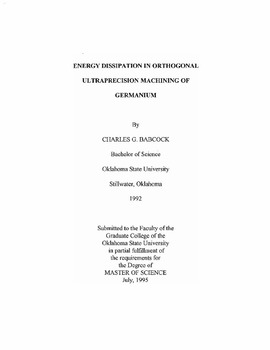| dc.description.abstract | Manufacturing processes that can produce accurate forn and finish on micron and submicron scales are essential. Processes fulfilling these criteria are called ultraprecision engineering, where the term 'ultraprecision' refers to the highest dimensional accuracy that can be achieved, relative to the capabilities at a given time. Perhaps, the most important such process for attaining high form and finish accuracy at a submicron scale is 'ultraprecision' machining, where form accuracies on the submicron level and surface roughnesses in the nanometer range can be produced [Lucca and Seo 1993, Taniguchi 1983, Seo 1993, Ikawa et at 1991]. Further improvement in ultraprecision machining is dependent on our ability to understand the fundamental behavior of the process. The process physics, at very small uncut chip thicknesses, is not well understood. Most of the current research has dealt with ductile materials such as copper and aluminum, with only cursory attention being paid to other less traditional materials. Brittle materials, for the most part, have been neglected. Topics that have been researched using ductile materials are energy dissipation in ultraprecision machining, the effect of the tool edge profile during the machining process, effect of cutting speed, temperature effects due to the process, the behavior of forces as a function of uncut chip thickness, and the depth of the subsurface damaged layer. Some studies using brittle materials are investigations into the crystal orientation dependence of machining damage by Blackley and Scattergood [1990], single point diamond turning of glasses by Puttick et a1. [1989], and the effect of material properties on the process by Furukawa [1988]. Other works include that presented by Nakasuji et aI. [1990] who published investigations on the diamond turning of brittle materials, the documentation of the apparent ductile transition in the facing of Si by Taylor et aI. [1987], as well as Blake and Scattergood's study of ductile regime machining ofGe and Si [1990]. Most studies have utilized a three dimensional cutting geometry, such as facing. This type of geometry does not allow for the isolation of the force system and makes determination of the uncut chip thickness problematic. These are necessary data for determining the process energies and isolating the effects of parameters such as the tool edge profile and cutting speed. These are important for determining the fundamental process physics at very small uncut chip thicknesses where, unlike traditional cutting, sliding at the flank: face and plowing at the tool edge have been cited as dominate mechanisms rather than conventional chip formation [Moriwaki 1989, Lucca and Seo 1991]. Using an orthogonal cutting geometry results in a two dimensional stress state which allows the force system to be isolated and its components accurately measured, as well as ensuring a constant uncut chip thickness. This is the same technique used by Lucca and Seo [1991] in their studies ofenergy dissipation in ultraprecision machining of oxygen free high conductivity (OFHC) copper. Data, where the forces generated at a known uncut chip thickness are known, have not been presented for brittle materials. This lack of accurate force data prevents the development of stress models for the cutting process. The aim of the research reported here is to conduct energy dissipation experiments using a brittle rather than a ductile material. Gennanium has been selected as the material for the experiments because of its use for infrared optical components, which provides a frame of reference whereby the results of the research achieve both a practical as well as a theoretical relevance. | |
